Daily Journal
September 24, 2004:
Teachers at Sea
Plus: Parting Thoughts
How is Scientific Data Collected Aboard the R/V Wecoma?
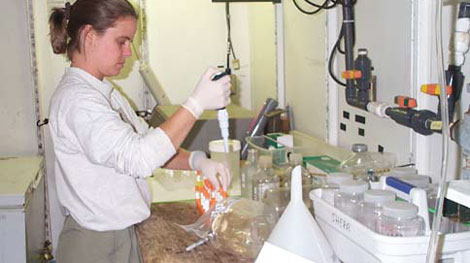
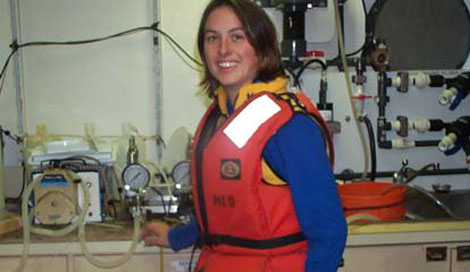
Top: Krista pipeting water samples
Above: Sarah filtering sea water
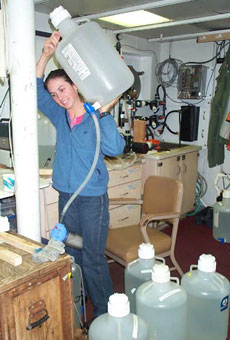 
Above left: Sarah filtering water in the Wet Lab
Above right: Aaron working under the hood
Below: The Photosynthetron exposing the samples to light
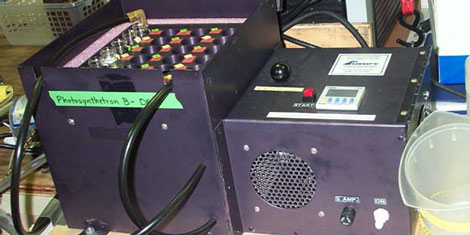

Above: EJ at the Filtration Station
Most of the data collected on this cruise is bottled up to take home to
the laboratories at OSU. The organisms we are collecting, such as phytoplankton and bacteria, cannot be seen with the naked eye, so are better studied under controlled conditions.
Some of the sea water we collect is filtered to eliminate the larger, but
still unseen, organisms. This is done at the Filtration Station. The
filters are also used to trap specific sized organisms to study for
analysis and chlorophyll content.
Another station is used by Zanna. She filters her water with 0.2 micron
filters to filter out the microorganisms, leaving any copper residue. She
then mixes the sample with chemicals to measure the light, which indicates
the amount of copper present.
Other sea water is tested on the ship in the Radioactive Laboratory that
is stationed on the upper deck. The organisms are injected with a
radioactive isotope so their activity can be traced and monitored.
Out on the aft deck, Sam deploys the TSRB and the Profiler (both
instruments that are lowered into the ocean) to read and enter data that
is measuring the amount of light and the effect of light on
microorganisms. The data is collected and stored electronically.
The instrument Sarah is using is condensing ocean water to increase the
density of the microorganisms. Every 120 liters of ocean water is
condensed to 250 milliliters. This is done with a tangential filter that
catches the organisms as the water flows past the filter. This process
condenses the ocean water retaining all the original organisms, keeping
them intact.
Here's a math problem that involves ratio.
If 120 liters of water condenses down to 250 milliliters, how many
milliliters of water would Sarah have after condensing 1000 liters of sea
water?
This math problem involves area and volume.
The stateroom we call "home" is very cozy. Susan and I have a little
"dance" when we are getting ready in the morning. It's like those little
puzzles with numbers that you slide back and forth to put them in order. I
step back, Susan goes to her drawer, Susan steps aside, Annie goes to her
drawer. Our little dance goes on morning and night. Now for the math
problem. Our room is 8 feet 10 inches long, 7 feet 8 inches wide, and 6
feet 5 inches high. What is the area of the floor of our room? And what is
the volume of our room? (Hint: The formula for area is: Area = length x
width. The formula for volume is: V = length x width x heighth.)
A math problem to measure volume of water.
Today is our last day at sea. The scientists want to collect extra sea
water to take back to their labs. The Rosette will be cast 6 times. Three
casts will be at the surface and three casts will be at 20 meters. The
Rosette has 12 cylinders, and each cylinder holds 5 liters of ocean water.
How much water will they collect from the six casts?
Parting Thoughts
This has been the journey of a lifetime for two land-based teachers. We
would like to thank the crew and the scientists of the R/V Wecoma for
their patience, their assistance, and the sharing of their knowledge and
expertise with us. We have learned much about the operation of a research
vessel and scientific processes in oceanography. We've also learned what
life at sea is like, and have respect and admiration with those who work
on the sea. It has also been a pleasure to work with such dedicated
scientists and to learn some about what each does in his/her field. We
also have a much better understanding of global issues relating to the
limits of our ocean resources.
Special thanks also to those of you on shore who have followed our journey
and supported us with your email and excellent feedback. Your
encouragement and good wishes have kept our spirits afloat. We would like
to especially thank our husbands and Susan Cowles for making this journey
a reality for us and for cheering us on through the ups and downs of life
at sea. We will miss seeing the sunrises and sunsets at sea and looking
for the North Star at night.
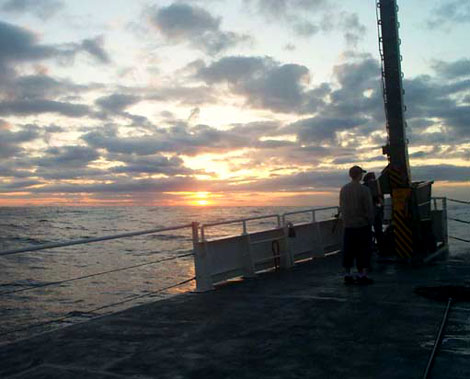
Sunset at sea from the aft deck
Back to Daily Journals

|







